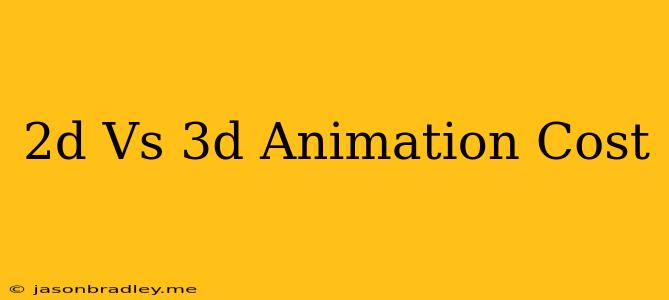2D vs 3D Animation: A Cost Breakdown
Animation is a powerful tool for bringing stories to life, engaging audiences, and communicating complex ideas. But the choice between 2D and 3D animation can significantly impact your budget. Understanding the cost differences between these two styles is crucial for making informed decisions.
2D Animation: Cost-Effective Storytelling
2D animation offers a more traditional and often budget-friendly approach. Here's a breakdown of the factors that contribute to its lower cost:
-
Simplified Production: 2D animation typically involves drawing individual frames, which can be done with software like Adobe Animate or Toon Boom Harmony. This process requires less complex software and technical expertise, making it more accessible to independent animators and smaller studios.
-
Shorter Production Time: The simplicity of 2D animation allows for faster production cycles. This translates to lower labor costs and potentially quicker turnaround times.
-
Lower Asset Requirements: 2D animation relies on fewer assets like character models and environments. Creating these assets is generally less demanding than 3D modeling, resulting in lower production costs.
However, 2D animation isn't without its limitations.
-
Limited Realism: While 2D animation can achieve impressive visual styles, it's inherently less realistic than 3D.
-
Static Environments: 2D environments can feel static and less interactive compared to their 3D counterparts.
-
Specific Skillsets: 2D animation requires specialized skills in drawing, animation principles, and software proficiency. Finding skilled artists can be challenging, potentially impacting your budget.
3D Animation: Immersive Visuals at a Higher Price
3D animation offers unmatched realism and flexibility, but comes with a higher price tag. Here's a breakdown of the factors influencing its cost:
-
Complex Production Process: 3D animation requires sophisticated software like Maya, 3ds Max, or Blender. Creating and animating 3D models, environments, and characters demands advanced technical skills and specialized hardware.
-
Longer Production Time: The complexity of 3D animation leads to longer production cycles, requiring more time for modeling, rigging, texturing, animating, and rendering.
-
High Asset Requirements: 3D animation involves creating extensive assets, including high-poly character models, detailed environments, and complex lighting setups. This requires significant time, expertise, and potentially outsourcing.
The benefits of 3D animation justify the higher cost for many projects.
-
Enhanced Realism: 3D animation can create stunningly realistic visuals, offering greater immersion and impact.
-
Dynamic Environments: 3D environments allow for complex interactions, camera movements, and a higher level of interactivity.
-
Diverse Applications: 3D animation is suitable for a wider range of projects, including film, games, VR experiences, and product demonstrations.
Making the Right Choice: 2D or 3D?
Choosing between 2D and 3D animation depends on your project's specific requirements, budget, and desired aesthetic.
-
Choose 2D animation if:
- Your budget is tight.
- You need a quick turnaround time.
- A stylized or cartoonish look is desired.
- You want a more traditional aesthetic.
-
Choose 3D animation if:
- You need a high level of realism.
- You want dynamic environments and complex camera movements.
- Your project requires immersive visual experiences.
- Your budget allows for the higher production costs.
Ultimately, the best choice comes down to balancing artistic vision with budget constraints. Consulting with experienced animators or production studios can provide valuable guidance and help you make an informed decision.
